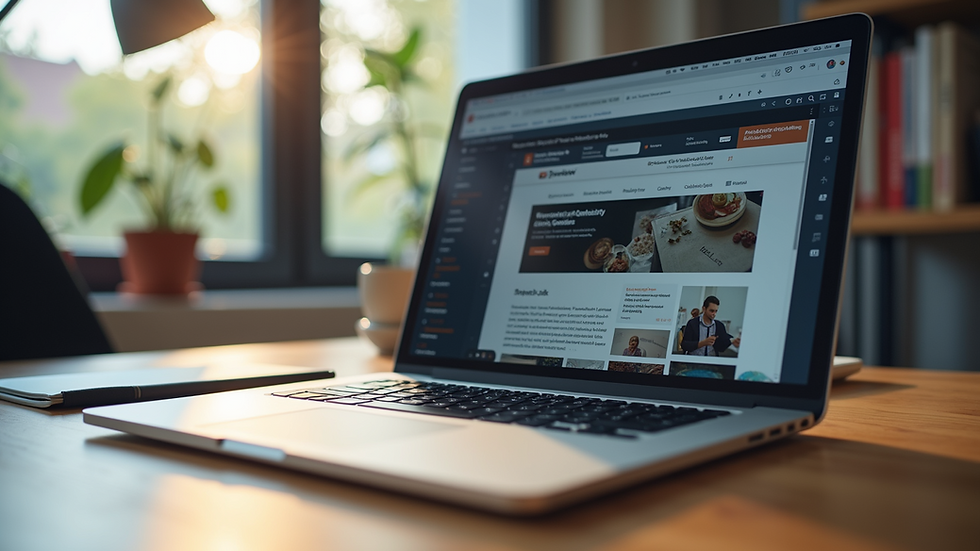Understanding the Essentials of Web Design in London
- Max Harrington

- Aug 14
- 4 min read
When it comes to creating a website that truly works for your business, there’s more to it than just picking a pretty layout. I’ve spent quite some time exploring what makes web design tick, especially here in London, where the market is as competitive as it is diverse. Whether you’re a small start-up or a well-established company, understanding the essentials of web design can make a world of difference.
Let’s dive into some practical insights and tips that will help you navigate the world of web design with confidence.
Why Web Design Matters More Than You Think - London Web Design Tips
You might be wondering why web design is such a big deal. After all, isn’t it just about making a site look nice? Not quite. Good web design is about creating an experience that visitors find easy, enjoyable, and trustworthy. It’s the first impression your business makes online, and in many cases, it’s the difference between a visitor sticking around or clicking away.
Here are a few reasons why web design is crucial:
User Experience (UX): A well-designed site guides visitors smoothly to what they need, whether it’s information, products, or services.
Brand Identity: Your website reflects your brand’s personality and values. Consistency in colours, fonts, and style builds recognition.
Search Engine Optimisation (SEO): Clean, well-structured design helps search engines understand your site, improving your chances of ranking higher.
Mobile Responsiveness: With more people browsing on phones, your site must look and work well on all devices.
In London, where businesses are constantly vying for attention, these factors become even more important. A website that’s clunky or outdated can quickly lose potential customers to competitors.

Key London Web Design Tips for Success
If you’re looking to get the most out of your website, here are some tips tailored to the London market and beyond:
1. Keep It Simple and Clear
Londoners appreciate efficiency. Your website should be straightforward, with clear navigation and concise content. Avoid clutter and focus on what matters most to your visitors.
2. Prioritise Speed
Slow websites are a no-go. People expect pages to load quickly, especially when they’re on the move. Optimise images, use reliable hosting, and keep scripts lean.
3. Use Local Flavour
Incorporate elements that resonate with your local audience. This could be through imagery, language, or references to London landmarks and culture. It helps build a connection and trust.
4. Make Contact Easy
Whether it’s a phone number, email, or contact form, make sure it’s easy to find. Consider adding a live chat feature for instant support.
5. Test Across Devices
Your site should look and function perfectly on desktops, tablets, and smartphones. Test regularly to catch any issues early.
6. Focus on Accessibility
Ensure your website is usable by everyone, including those with disabilities. Use proper contrast, alt text for images, and keyboard-friendly navigation.
By following these tips, you’ll be well on your way to creating a website that not only looks great but also performs exceptionally well.

How Much Do Web Designers Charge in the UK?
One of the most common questions I get asked is about pricing. How much should you expect to pay for web design services in the UK? The answer isn’t straightforward, as costs vary depending on several factors:
Project Scope: A simple brochure site will cost less than a complex e-commerce platform.
Experience and Reputation: Established agencies or freelancers with a strong portfolio often charge more.
Custom Features: Integrations, animations, and bespoke functionality add to the price.
Ongoing Support: Maintenance, updates, and SEO services can be part of the package or extra.
To give you a rough idea:
| Type of Website | Typical Price Range (GBP) |
|-------------------------|----------------------------|
| Basic Informational Site | £500 - £2,000 |
| Small Business Website | £2,000 - £5,000 |
| E-commerce Site | £5,000 - £15,000+ |
| Custom Web Applications | £15,000 and upwards |
Remember, cheaper isn’t always better. Investing in quality design can save you money in the long run by reducing bounce rates and increasing conversions.
If you want a reliable partner, consider checking out web design london specialists who understand the local market and can tailor solutions to your needs.
The Role of Content in Web Design
Design and content go hand in hand. No matter how stunning your site looks, if the content doesn’t speak to your audience, it won’t convert visitors into customers.
Here’s what I recommend:
Clear Headlines: Grab attention and explain what you offer right away.
Concise Text: Keep paragraphs short and to the point.
Calls to Action (CTAs): Guide visitors on what to do next, whether it’s “Get a Quote” or “Learn More.”
Visuals: Use images and videos to complement your message, but don’t overload the page.
Good content also supports SEO, helping your site rank better in search results. Make sure to include relevant keywords naturally and provide valuable information.
Staying Ahead with Trends and Technology
Web design is always evolving. Staying current with trends and technology can give your business an edge. Here are a few trends worth considering:
Minimalist Design: Clean layouts with plenty of white space.
Dark Mode: Offering a dark theme option for user comfort.
Micro-Interactions: Small animations that enhance user experience.
Voice Search Optimisation: Preparing your site for voice queries.
AI Chatbots: Providing instant customer support.
While it’s tempting to jump on every trend, focus on what fits your brand and audience. A timeless design that works well is better than a flashy one that confuses visitors.

Making Your Website Work Harder for You
Ultimately, your website should be a tool that helps your business grow. Here are some practical steps to ensure it delivers results:
Set Clear Goals: Know what you want your site to achieve - more enquiries, sales, or brand awareness.
Use Analytics: Track visitor behaviour to understand what’s working and what isn’t.
Regular Updates: Keep content fresh and relevant.
Integrate Marketing: Link your site with social media, email campaigns, and other channels.
Get Professional Help: Don’t hesitate to work with experts who can bring your vision to life.
By taking these steps, you’ll create a website that not only looks good but also supports your business objectives effectively.
I hope these insights help you feel more confident about web design and what it takes to succeed in London’s vibrant market. Remember, a well-crafted website is an investment that pays off in the long run. If you’re ready to take the next step, exploring options with a trusted web design london studio could be just what you need.






Comments